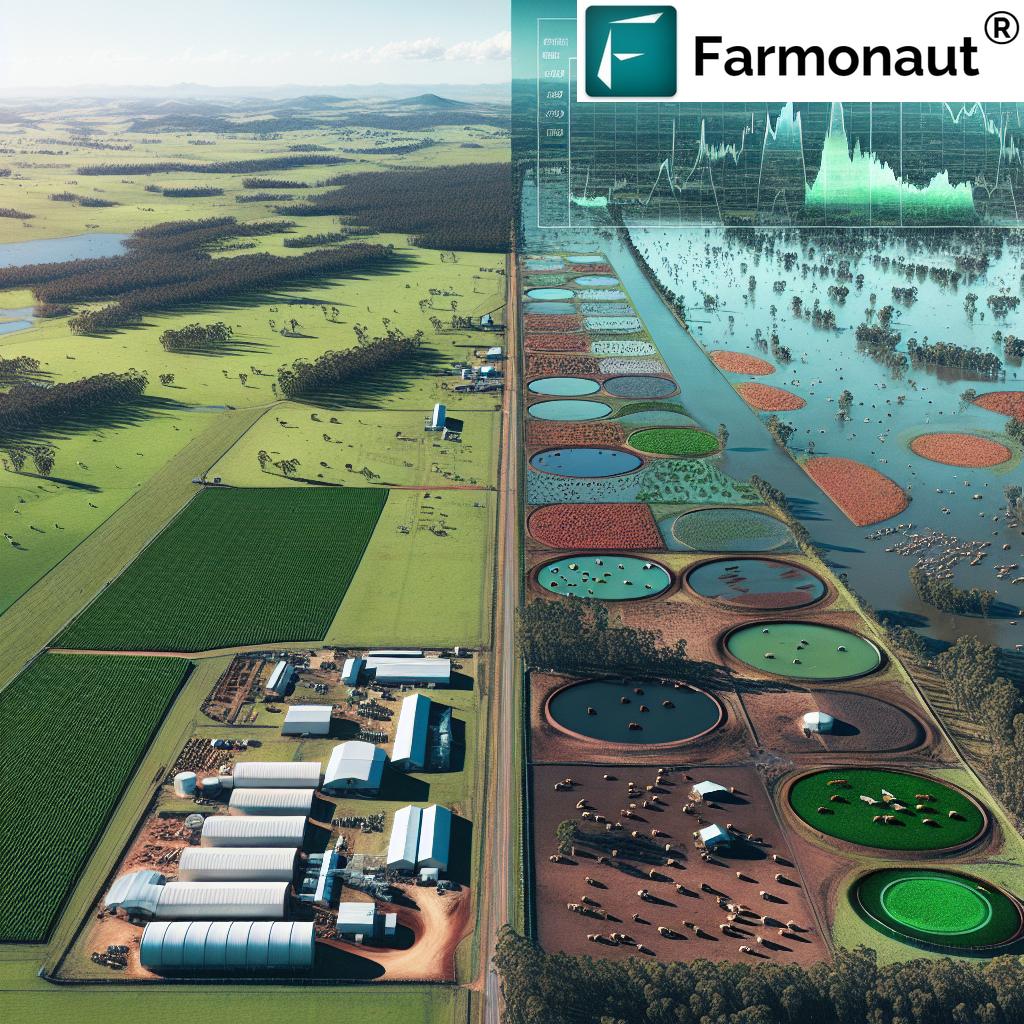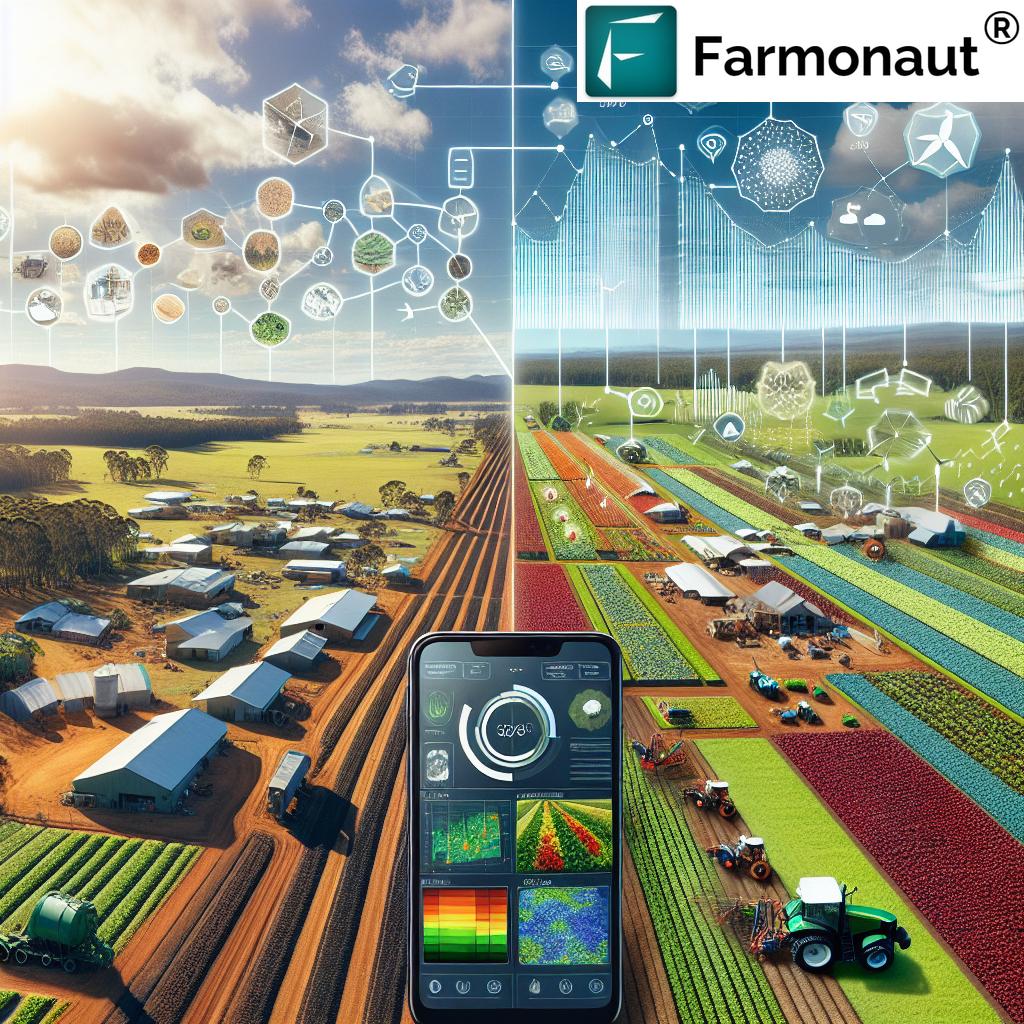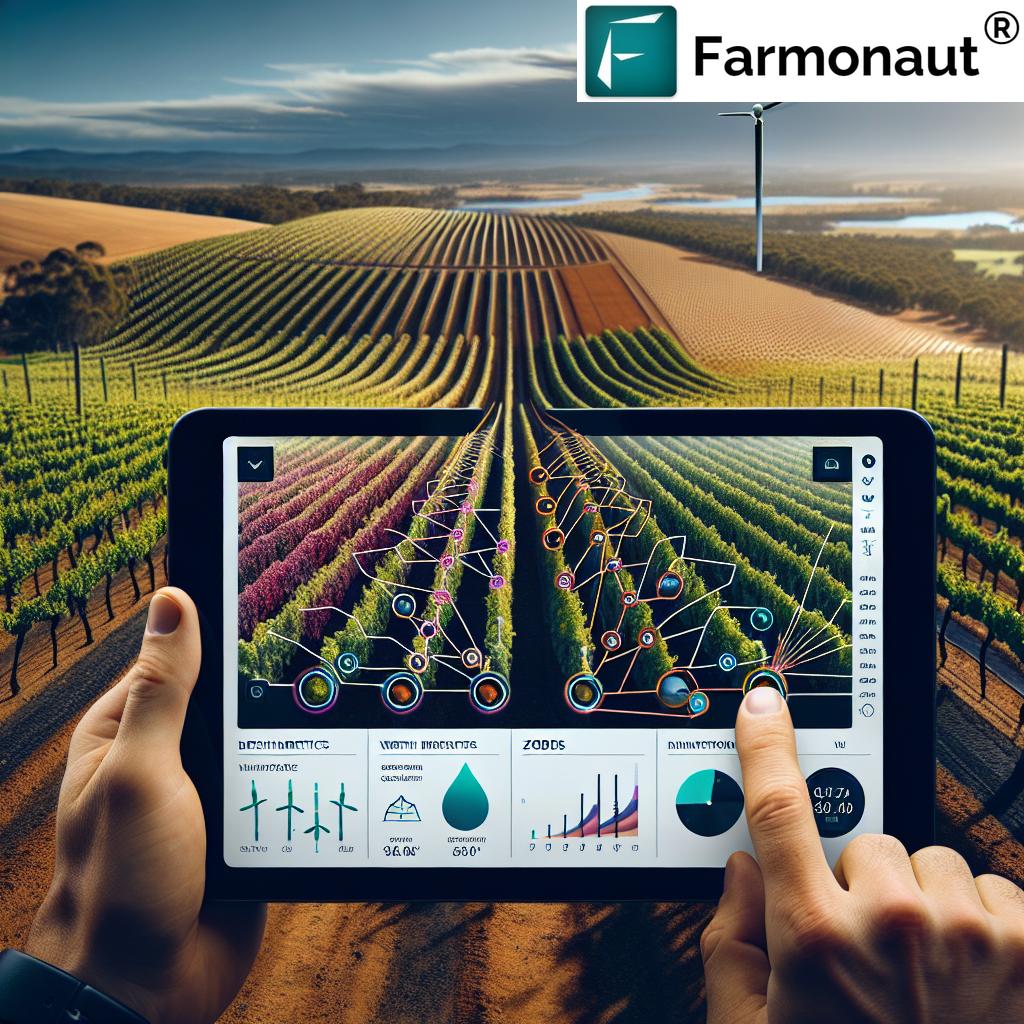Farmonaut’s Guide: Smart Farming Technologies for NSW Flood and Storm Preparedness

“Farmonaut’s smart farming technologies can help monitor over 20 different weather parameters for enhanced flood preparedness.”
In the face of increasingly unpredictable weather patterns, New South Wales (NSW) farmers are confronted with the pressing need for robust flood and storm preparedness strategies. As we navigate the complexities of modern agriculture, the integration of smart farming technologies has become crucial in bolstering our defenses against natural disasters. In this comprehensive guide, we’ll explore how Farmonaut’s cutting-edge solutions are revolutionizing agricultural disaster management and enhancing climate resilience for NSW’s farming communities.
Understanding the Challenge: Floods and Storms in NSW Agriculture
NSW’s agricultural sector faces significant challenges from floods and storms, which can devastate crops, threaten livestock, and disrupt farm operations. These emergencies demand a proactive approach to farm emergency planning and the implementation of advanced agricultural disaster management techniques. By leveraging smart farming technologies, we can significantly improve our preparedness and response to these events.
The Impact of Extreme Weather on NSW Farms
- Crop damage and loss
- Soil erosion and nutrient depletion
- Livestock stress and potential loss
- Infrastructure damage
- Disruption to planting and harvesting schedules
To address these challenges effectively, we must adopt a multifaceted approach that combines traditional farming wisdom with modern agtech solutions. This is where Farmonaut’s smart farming technologies come into play, offering invaluable support for weather monitoring and precision agriculture.
Farmonaut’s Smart Farming Technologies: A Game-Changer for NSW Farmers
Farmonaut’s suite of advanced agricultural technologies is designed to empower farmers with real-time data and actionable insights. By harnessing the power of satellite imagery, artificial intelligence, and machine learning, we provide NSW farmers with the tools they need to make informed decisions in the face of impending floods and storms.
Key Features of Farmonaut’s Smart Farming Platform
- Satellite-Based Crop Health Monitoring: Real-time insights into vegetation health (NDVI) and soil moisture levels.
- Jeevn AI Advisory System: Personalized farm advice and weather forecasts powered by artificial intelligence.
- Precision Agriculture Mapping: Identify vulnerable areas and optimize resource allocation.
- Weather Data Integration: Comprehensive weather monitoring for enhanced preparedness.
These technologies work in synergy to provide a holistic approach to flood preparation for farmers and storm impact mitigation on crops. By integrating Farmonaut’s solutions into their operations, NSW farmers can significantly enhance their climate resilience and preparedness for extreme weather events.
Flood Preparation for Farmers: A Comprehensive Strategy
Effective flood preparation is crucial for minimizing the impact of these devastating events on agricultural operations. We’ve developed a comprehensive strategy that combines Farmonaut’s smart farming technologies with proven emergency management techniques to help NSW farmers safeguard their livelihoods.
1. Farm Infrastructure Assessment and Protection
- Conduct regular inspections of farm buildings, fences, and equipment
- Implement flood-proofing measures for critical infrastructure
- Develop an evacuation plan for machinery and valuable assets
2. Livestock Safety During Natural Disasters
Ensuring the safety of livestock is paramount during flood and storm events. Farmonaut’s technologies can assist in this crucial aspect of farm emergency planning:
- Use satellite imagery to identify safe, elevated areas for livestock relocation
- Implement early warning systems for rapid response
- Develop a comprehensive animal evacuation plan
- Ensure adequate feed and water supplies are stored in flood-safe locations
3. Crop Protection Strategies
Protecting crops from flood and storm damage requires a combination of preventive measures and smart farming techniques:
- Implement erosion control measures based on precision agriculture mapping
- Use Farmonaut’s crop health monitoring to assess vulnerabilities
- Plan for rapid drainage systems in flood-prone areas
- Consider flood-tolerant crop varieties for high-risk zones
Explore Farmonaut’s API for advanced weather data integration
4. Water Management and Drainage
Effective agricultural water management is crucial for mitigating flood impacts:
- Utilize Farmonaut’s soil moisture data to optimize drainage systems
- Implement water retention strategies for drought periods
- Regularly maintain and clear waterways and drainage channels
Agricultural Disaster Management: Leveraging Technology for Resilience
In the face of increasing climate variability, agricultural disaster management has become a critical component of sustainable farming practices. Farmonaut’s smart farming technologies play a pivotal role in enhancing the resilience of NSW farms against floods and storms.
Integrating Precision Agriculture and Climate Resilience
Precision agriculture, powered by Farmonaut’s satellite-based solutions, offers NSW farmers unprecedented insights into their land and crops. This data-driven approach enables more effective disaster management strategies:
- Identify high-risk areas prone to flooding or erosion
- Optimize planting schedules based on weather forecasts and soil conditions
- Implement targeted irrigation and drainage solutions
- Monitor crop health in real-time to assess storm impact and recovery needs
“Implementing sustainable agriculture practices can reduce storm-related crop losses by up to 30% in flood-prone areas.”
Early Warning Systems and Rapid Response
Farmonaut’s advanced weather monitoring capabilities provide NSW farmers with crucial early warning systems:
- Receive real-time alerts for approaching storms and potential flood events
- Access detailed weather forecasts to plan farm activities and preparedness measures
- Utilize AI-powered recommendations for immediate action steps
Access Farmonaut’s API Developer Docs for customized solutions
Sustainable Agriculture Practices for Storm Impact Mitigation
Incorporating sustainable agriculture practices is essential for long-term resilience against floods and storms. These practices not only help mitigate immediate impacts but also contribute to overall farm health and productivity.
Key Sustainable Practices for NSW Farms
- Cover Cropping: Reduce soil erosion and improve water retention
- Conservation Tillage: Enhance soil structure and water infiltration
- Agroforestry: Implement windbreaks and riparian buffers for storm protection
- Crop Rotation: Improve soil health and reduce pest pressures
- Integrated Pest Management: Minimize chemical inputs and promote natural pest control
Farmonaut’s technologies support these practices by providing detailed insights into soil health, crop performance, and environmental conditions. This data enables farmers to make informed decisions about implementing and optimizing sustainable agriculture techniques.
Community Engagement and Support Services
Effective agricultural disaster management extends beyond individual farm boundaries. Community engagement and access to support services are crucial components of a comprehensive preparedness strategy.
Building Resilient Farming Communities in NSW
- Participate in local emergency planning committees
- Share resources and knowledge with neighboring farms
- Engage with agricultural extension services for expert advice
- Collaborate on regional flood mitigation projects
Accessing NSW Government Support
NSW offers various support services for farmers affected by floods and storms:
- Emergency financial assistance
- Technical support for farm recovery
- Mental health services for affected farmers and communities
- Agricultural advisory services for long-term resilience planning
Farmonaut’s platform can assist in documenting farm conditions before and after disasters, providing valuable data for support applications and insurance claims.
Post-Disaster Recovery and Adaptation
Recovery after a flood or storm event is a critical phase that requires careful planning and execution. Farmonaut’s technologies continue to provide valuable support during this period.
Key Recovery Activities
- Damage Assessment: Use satellite imagery to quickly assess affected areas
- Soil Health Restoration: Analyze soil conditions and plan remediation efforts
- Crop Replanning: Utilize AI recommendations for optimal replanting strategies
- Infrastructure Repair: Prioritize repairs based on comprehensive farm data
- Adaptation Planning: Develop long-term strategies to enhance future resilience
Seasonal Pest Management and Plant Biosecurity
Floods and storms can significantly impact pest populations and plant health, making seasonal pest management and plant biosecurity critical components of post-disaster recovery and ongoing farm management.
Integrated Pest Management Strategies
- Monitor pest populations using Farmonaut’s crop health data
- Implement biological control methods where possible
- Use targeted pesticide applications based on precision agriculture data
- Maintain field hygiene to prevent pest spread
Enhancing Plant Biosecurity
Plant biosecurity is crucial for protecting NSW’s agricultural industries from introduced pests and diseases, especially after flood events that can spread pathogens:
- Implement strict quarantine measures for new plant material
- Regularly inspect crops for signs of disease using Farmonaut’s monitoring tools
- Collaborate with local biosecurity officers for early detection and response
- Participate in industry-wide biosecurity initiatives
Emergency Preparedness Checklist for NSW Farmers
To help NSW farmers prepare for floods and storms, we’ve compiled a comprehensive checklist incorporating Farmonaut’s smart farming technologies:
| Preparedness Category | Action Items | Priority Level | Farmonaut Technology Support |
|---|---|---|---|
| Farm Infrastructure |
– Elevate electrical systems – Secure chemical storage – Reinforce buildings |
High | Satellite imagery for infrastructure mapping and vulnerability assessment |
| Livestock Management |
– Identify high ground for evacuation – Prepare emergency feed supplies – Establish animal identification system |
High | AI-powered advisory for optimal livestock relocation areas |
| Crop Protection |
– Implement erosion control measures – Plan for rapid drainage – Consider flood-tolerant varieties |
High | Precision agriculture mapping for vulnerable areas and crop health monitoring |
| Water Management |
– Clear drainage channels – Install/maintain pumps – Create water retention areas |
Medium | Soil moisture data for optimized drainage planning |
| Emergency Communication |
– Establish communication plan – Prepare emergency contact list – Invest in reliable communication devices |
Medium | Integration with early warning systems and weather alerts |
Conclusion: Embracing Smart Farming for a Resilient Future
As we face the challenges of climate change and increasingly unpredictable weather patterns, NSW farmers must adapt and evolve. Farmonaut’s smart farming technologies offer a powerful toolkit for enhancing flood and storm preparedness, minimizing risks, and optimizing recovery efforts. By integrating these advanced solutions with traditional farming wisdom and sustainable practices, we can build a more resilient and productive agricultural sector in NSW.
Remember, preparedness is an ongoing process. Regularly review and update your farm emergency plan, stay informed about the latest developments in agricultural technology, and engage with your local farming community. Together, we can weather the storms and floods, ensuring the continued success and sustainability of NSW agriculture.
Frequently Asked Questions (FAQ)
- How can Farmonaut’s technologies help me prepare for floods and storms?
Farmonaut provides real-time satellite imagery, weather data, and AI-powered insights to help you monitor crop health, predict weather patterns, and make informed decisions about farm management and emergency preparedness. - Is Farmonaut’s platform suitable for small-scale farmers in NSW?
Yes, Farmonaut’s solutions are designed to be accessible and affordable for farmers of all scales, from small family farms to large agricultural operations. - How often is the satellite imagery updated on Farmonaut’s platform?
The frequency of updates depends on the subscription plan, but typically ranges from daily to weekly updates, ensuring you have access to current data for decision-making. - Can Farmonaut’s technologies help with insurance claims after a flood or storm?
Yes, Farmonaut’s detailed crop health data and historical imagery can provide valuable documentation to support insurance claims for crop losses due to natural disasters. - How does Farmonaut integrate with existing farm management systems?
Farmonaut offers API access, allowing for seamless integration with other farm management tools and software you may already be using.

















